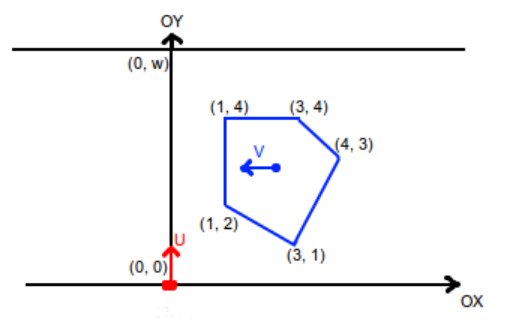codeforces 703 C. Chris and Road
来源:互联网 发布:退伍军人召回通知软件 编辑:程序博客网 时间:2024/05/01 08:46
And while Mishka is enjoying her trip...
Chris is a little brown bear. No one knows, where and when he met Mishka, but for a long time they are together (excluding her current trip). However, best friends are important too. John is Chris' best friend.
Once walking with his friend, John gave Chris the following problem:
At the infinite horizontal road of width w, bounded by lines y = 0 and y = w, there is a bus moving, presented as a convex polygon of nvertices. The bus moves continuously with a constant speed of v in a straight Ox line in direction of decreasing x coordinates, thus in time only x coordinates of its points are changing. Formally, after time t each of x coordinates of its points will be decreased by vt.
There is a pedestrian in the point (0, 0), who can move only by a vertical pedestrian crossing, presented as a segment connecting points(0, 0) and (0, w) with any speed not exceeding u. Thus the pedestrian can move only in a straight line Oy in any direction with any speed not exceeding u and not leaving the road borders. The pedestrian can instantly change his speed, thus, for example, he can stop instantly.
Please look at the sample note picture for better understanding.
We consider the pedestrian is hit by the bus, if at any moment the point he is located in lies strictly inside the bus polygon (this means that if the point lies on the polygon vertex or on its edge, the pedestrian is not hit by the bus).
You are given the bus position at the moment 0. Please help Chris determine minimum amount of time the pedestrian needs to cross the road and reach the point (0, w) and not to be hit by the bus.
The first line of the input contains four integers n, w, v, u (3 ≤ n ≤ 10 000, 1 ≤ w ≤ 109, 1 ≤ v, u ≤ 1000) — the number of the bus polygon vertices, road width, bus speed and pedestrian speed respectively.
The next n lines describes polygon vertices in counter-clockwise order. i-th of them contains pair of integers xi and yi ( - 109 ≤ xi ≤ 109,0 ≤ yi ≤ w) — coordinates of i-th polygon point. It is guaranteed that the polygon is non-degenerate.
Print the single real t — the time the pedestrian needs to croos the road and not to be hit by the bus. The answer is considered correct if its relative or absolute error doesn't exceed 10 - 6.
5 5 1 21 23 14 33 41 4
5.0000000000
Following image describes initial position in the first sample case:

嗯,愚昧的我只想到了y=u/v *x这个方程e……
看了题解,感觉别人好聪明,分情况:
1.车太快,人可以在每辆车行驶过去全速到达对岸
2.车太慢,人可以在每辆车撞到之前全速到达对岸
3.人车在行驶过程中会相撞,人得躲避车
第三种,计算对人影响最大的车,通过的时间
(略懂)
代码:
#include<cstdio>#include<algorithm>using namespace std;int main(){int n;double w,v,u;double x,y,ans=0;scanf("%d%lf%lf%lf",&n,&w,&v,&u);int i;int flag1=0,flag2=0;for(i=0;i<n;i++){scanf("%lf%lf",&x,&y);if(x/v>y/u)flag1=1;if(x/v<y/u)flag2=1;ans=max(ans,x/v+(w-y)/u);}if(flag1==0||flag2==0)//第一或第二种情况发生 ans=w/u;printf("%.7lf\n",ans);return 0;}二分的没这个简单
给个链接:点我
- codeforces 703C Chris and Road
- CodeForces - 703C Chris and Road
- CodeForces 703C Chris and Road
- codeforces 703 C. Chris and Road
- 【23.15%】【codeforces 703C】Chris and Road
- CodeForces 703C Chris and Road (几何,二分)
- Codeforces 703C Chris and Road 二分、思考
- 【CodeForces】703C - Chris and Road(思维,好题)
- Codeforces 703C Chris and Road(计算几何)
- CodeForces 703 C.Chris and Road(贪心)
- [CF 703C]Chris and Road
- Codeforces Round #365 (Div. 2) [C] Chris and Road
- Codeforces Round #365 (Div. 2) C. Chris and Road
- Codeforces Round #365 (Div. 2) C. Chris and Road 【数学】
- Codeforces Round #365 (Div. 2) C. Chris and Road(计算几何+二分)
- Codeforces Round #365 (Div. 2) C. Chris and Road(计算几何+二分)
- Codeforces Round #365 (Div. 2) -- C. Chris and Road (思路水题)
- Codeforces Round #365 (Div. 2) C. Chris and Road 实数级的二分法、几何
- 上传Excel文件并读取存入数据库
- Python logging模块详解
- 接口和抽象类的区别
- HDU 1022 Train Problem I 简单的栈
- angularJS
- codeforces 703 C. Chris and Road
- Objective-C中的设计模式--NSNotification通知
- 王宝强案:最让人心痛的,可能还没到来!
- 一寸照片制作
- POJ 3335 Rotating Scoreboard
- 阻塞队列 BlockingQueue
- android dialog 按钮监听拦截问题
- 麻将 (Standard IO)
- adapter.notifyDataSetChanged()不起着用


